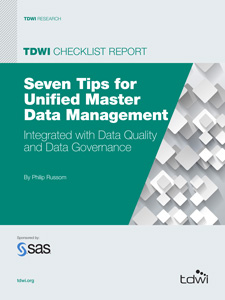
TDWI Checklist Report | Seven Tips for Unified MDM with Data Quality and Data Governance
May 13, 2014
Master data management (MDM) can be practiced many different
ways, with various user conventions and a broad array of vendor-built
technologies. However, this report focuses on a specific practice called
unified MDM. Its seven leading characteristics are:
- MDM in the context of a unified program for many data
management disciplines. Unified data management (UDM)
is a best practice for coordinating diverse data management
disciplines. UDM enables MDM to leverage competency synergies
with related disciplines, such as data quality, data integration,
and data governance.
- MDM as one of many solutions built atop a unified
vendor framework supporting many functions for data
management. By using a vendor’s unified toolset, developers
can share development artifacts (for productivity and consistent
standards), plus design solutions that incorporate diverse DM
functions. The initial investment in a vendor’s unified platform
reduces system integration and other costs over time because
multiple MDM solutions are built on top of it. A unified platform
also accelerates time-to-use for DM projects.
- MDM as a series of easily managed projects. This phased
approach avoids risky big-bang projects, and it enables an
organization to incrementally grow into multiple MDM solutions
that in aggregate amount to enterprise coverage for MDM.
- MDM controlled and guided by data governance and data
stewardship. Master and reference data are like all data in that
they are subject to the enterprise regulations of governance as
well as detailed improvement via data stewardship. A modern,
unified platform will provide software functions that automate
governance and stewardship tasks.
- MDM continuously improved by multiple data quality
functions. Master and reference data benefit strongly from
quality measures for standardization, address verification, data
enrichment, profiling, monitoring of quality metrics, and so on.
- MDM for business people who act as hands-on stewards, not
just technical personnel. A growing number of stewards want
and need tool functions designed for them, such as profiling,
search, collaboration, and remediation.
- MDM organized and optimized via a hub. Many high-value
features of MDM are more broadly disseminated when enabled
through a hub, namely collaboration among multiple stake
holders, one-stop governance and stewardship, entity resolution,
and publish/subscribe methods.
This TDWI Checklist Report examines these characteristics typical of
business programs and technical solutions for unified MDM.
Definitions of Data Disciplines
We’ll start with basic definitions for some of the data disciplines
discussed in this report:
Master data management (MDM) is the practice of developing
and maintaining consistent definitions of business entities (e.g.,
customers, products, financials, and partners). MDM’s entity
definitions and reference data facilitate the accurate sharing of data
across the IT systems of multiple departments and possibly outward
to business partners. This way, MDM can improve many data-driven
initiatives, such as business intelligence, integrating business units
via common data, 360-degree views, supply chain efficiency, the
compliant use of data, and customer interactions that span multiple
touch points.
Data quality (DQ) is a family of related data-management techniques
and business-quality practices, applied repeatedly over time as the
state of quality evolves, to assure that data is accurate, up-to-date,
and fit for its intended purpose. The most common data quality
techniques are name-and-address cleansing and data standardization.
Other techniques include verification, profiling, monitoring, matching,
merging, householding, postal standards, geocoding, and data
enrichment.
Data governance (DG) is the creation and enforcement of policies and
procedures for the business use and technical management of data.
It is usually the responsibility of an executive-level board, committee,
or other organizational structure, although DG is sometimes executed by individuals without a formal organization. Common goals of data
governance are to define ownership; improve data’s quality; remediate
its inconsistencies; share data broadly; leverage its aggregate for
competitive advantage; manage change relative to data usage; and
comply with internal and external regulations and standards for data
usage. The scope of data governance can vary greatly, from the data
of a single application to all the data in an organization.
Data stewardship (DS) is usually performed by a business manager
who knows how data affects the performance of his/her business unit
or the enterprise. In addition to daily management responsibilities, a steward collaborates with data management specialists and data
governors to direct DM work so it supports business goals and
priorities. Many stewards use business-friendly tools to explore andprofile data, plus remediate errant or non-compliant data.